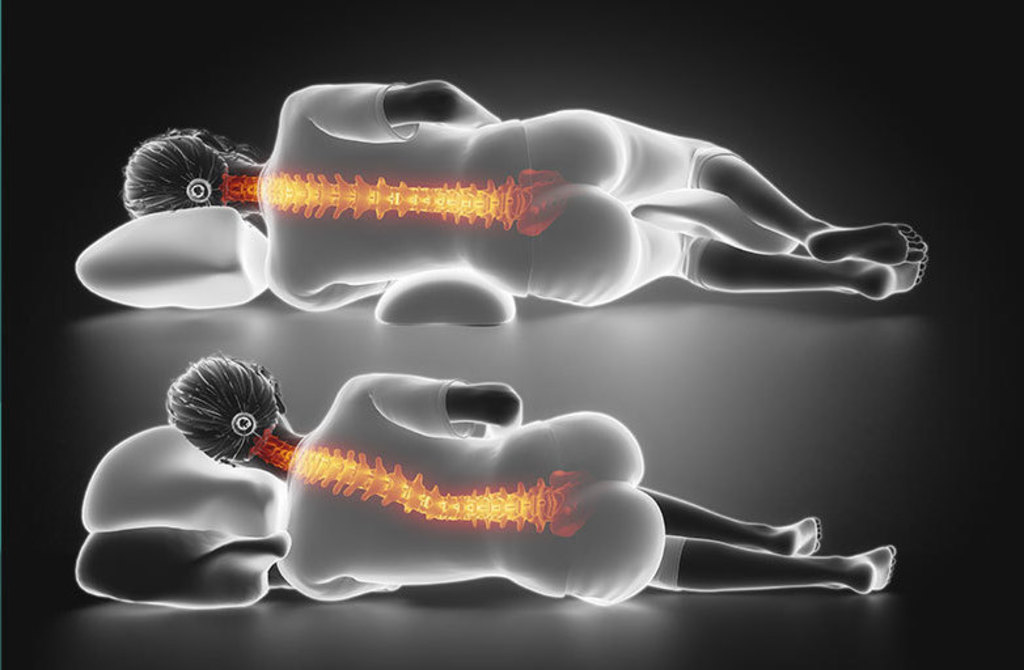Pillow Talk: The Importance of Sleep Posture

Having the right pillow can make all the difference in getting a good night’s sleep, especially if you have head or neck pain. The purpose of a pillow is to support to your head and neck in good posture as you sleep. Which pillow fits you best depends on two factors: the side/shape of your body and what position you sleep in.
Neutral Position
The first step to choosing the perfect pillow is understanding what position your head and neck should be in. Whether you are sitting, standing or laying down, the optimal head position is neutral. In neutral, your head is positioned centered on your body facing forward, not tipped or rotated in any direction. This position optimizes spinal alignment and minimizes stress on the muscles, ligaments and tendons. When you are laying down, the pillow should be supporting your head so that it can rest in a neutral position.
One good way to see what position your head is in when you are sleeping is to have someone sit at the side of your bed and take pictures of you laying down with your pillow. Look at the pictures and analyze the position of your head in relationship to your body. Is is positioned in neutral? When you are laying on your side, the pillow needs to fill the space between the bed and your head. If the pillow is too thin, your head will be tipped down toward the bed and if it is too thick your head will be tipped up toward the ceiling. When laying on your back, the pillow needs to fill the space between the bed and the back of your head. If the pillow is too thin, your head will be tipped back toward the bed and if it is too thick your head will be tipped up toward your chest. Also, look at the curve of your neck. Your pillow should be completely filling that space and supporting your neck.
Pillow Types
A good pillow is made of something that is both flexible and resilient. You need to be able to form it to the curve of your neck to support it but it still has to be solid enough to support the weight of your head. Feather pillows or synthetic pillows with similar qualities to feathers do this very well. They are also easy to reshape as you change sleeping position.
Memory foam pillows do a good job of supporting the head when you are laying on your back, but are often too firm to cradle and support the neck well. You can’t fold them to adjust the thickness, so they are usually not thick enough to provide good support when you are laying on your side.
Some pillows are shaped specifically for back or side sleepers. But they are not one size fits all. The curved part of the pillow meant to support your neck is not adjustable, so for many people, they are either too large or too small. Also, very few people stay in one position when they are sleeping. So, for instance, if you are using a pillow designed for a side sleeper and you roll onto your back, the pillow cannot adjust to your new position and will not give you the support you need.
The Pillow Test
Pillows wear out over time, so if your pillow is older, check to see if it still has enough loft to do it’s job. Try this test: fold the pillow in half and release it. It should bounce back to it’s original shape. If it doesn’t, it is no longer able to loft up and provide you with enough support. Replace it.
Stomach Sleepers
What about sleeping on your stomach? If you have neck pain, you have likely been told that you should not sleep on your stomach. Applying what we now know about head posture, you can see that the reason for this is that in order to breathe while you are sleeping on your stomach you have to position your head rotated to the extreme right or left. This position is very stressful on the neck. If you can train yourself to avoid sleeping in this position, do. But changing your preferred sleeping position can be very difficult and you may find yourself rolling onto your stomach in your sleep. In order to protect your neck while laying on your stomach you need to position your head as close to neutral as possible while still allowing room to breathe. One way to do this is by resting your forehead on the edge of the pillow. This allows your head to stay in neutral while providing room to breathe. Another is to ditch the pillow altogether and rest your head in the crook of your elbow. This allows you to breathe with your head positioned only slightly in rotation.
Here’s to perfect pillows and a good night’s sleep!
by
Πρόσφατα Άρθρα

Your child’s posture may be more important than you think
Good posture promotes better breathing which leads to more air, more oxygen, and more brain food. This results in improved concentration, thoughts and ideas for ‘better learning.’
With t...

Bad Habits in Children
- Two thirds of parents report never giving posture advice to their children
- A typical 18-24 year old spends 8.83 hours a day in front of a screen ...

Pillow Talk: The Importance of Sleep Posture
Having the right pillow can make all the difference in getting a good night’s sleep, especially if you have head or neck pain. The purpose of a pillow is to support to your head and neck in good po...
